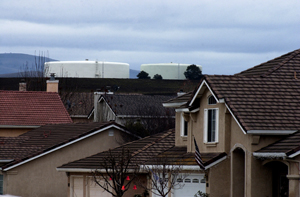Sunnyslope decides between Hollister connection or their own
upgrade
On Jan. 10, the board of directors for the Sunnyslope County
Water District will decide whether the district will upgrade their
wastewater facilities or use Hollister’s wastewater treatment
facilities.
Sunnyslope decides between Hollister connection or their own upgrade
On Jan. 10, the board of directors for the Sunnyslope County Water District will decide whether the district will upgrade their wastewater facilities or use Hollister’s wastewater treatment facilities.
Sunnyslope provides water for 5,300 customers, said BrianYamaoka, the general manager for the Sunnyslope water district. Only 1,200 of those customers utilize the district’s wastewater facilities, he said.
All of Sunnyslope’s wastewater customers live in an unincorporated area of San Benito County, he said.
Regardless of what the board decides, wastewater rates will go up, he said.
“We have no choice,” Yamaoka said.
Current rates are about $34 a month for wastewater, he said.
The Sunnyslope district currently has a pond sewer system that uses anaerobic bacteria to clean waste out of the water, similar to the one Hollister has been using. Sunnyslope is looking to upgrade to a mechanical system that would reach a higher standard of cleaning wastewater.
Wastewater rates for Hollister’s customers will be $124 by January 2011, according to documents from Yamaoka.
Sunnyslope wastewater customers would pay about $100 per month for water if they upgrade their system or connect to Hollister’s, Yamaoka said.
“Our customers are going to pay a minimum of $100 no matter what,” Yamaoka said.
It would cost $1.4 million to upgrade Sunnyslope’s facilities, according to documents from Yamaoka. It would cost $1.6 million to hook into Hollister’s facilities, according to the documents.
“The difference in cost one way or another is a statistical dead heat,” said Doug Keck, a board member for Sunnyslope. “As a determining factor, cost probably isn’t one.”
All the numbers are projections, Keck said. The actual construction costs and rates may vary, he said.
The Central Coast Regional Water Quality Control Board, a state agency responsible for quality standards for wastewater, has required Sunnyslope to take action.
The standards go into effect January 2008, but Sunnyslope officials asked for an extension until 2010, Yamaoka said.
One concern is the amount of salt in Sunnyslope’s wastewater.
“Basically, the stuff that comes out of the sewer treatment plant has to be a lot more pure,” Keck said
The new system would also bring the wastewater into compliance for the amount of nitrate and ammonia in it, a concern if the treated water is to be reused.
Water in the Hollister area is naturally hard, Yamaoka said, meaning there are lots of minerals in the water that can cause damage to household pipes and appliances. The downside of using water softeners is that they add salt to the water.
The rate increase for treated drinking water will be comparable to the rate increase for treated wastewater, he said. Sunnyslope customers would pay about $100 for drinking water. Wastewater customers would pay an additional $100 for wastewater.
In early December, Sunnyslope officials had a presentation for their customers, Keck said. The meeting was packed, he said.
“If you could get a couple hundred people to come hear about sewage treatment, you’ve probably got a hot issue,” he said.
Using Hollister’s new facilities or upgrading existing facilities is about local control, he said.
“Do we, as a small district, want to control our own fate or join with a bigger and possibly more efficient system?” he said, referring to Hollister’s facilities. “All the people that I hear don’t want to hook up with Hollister.”
Once the upgrades are complete, the wastewater would be pure enough for use in landscaping, Keck said. What happens to the reclaimed water would be up to Hollister’s city council if Sunnyslope residents opt to connect to the city’s services, he said.
“If we do the treatment ourselves, we will be able to decide what to do with the wastewater ourselves,” Keck said, “and not have to concern ourselves with whether Hollister wants to give us the water back.”
Officials from the Central Coast Regional Water Quality Control Board would prefer that Sunnyslope use Hollister’s facilities, Keck said. Having one system would create less work for them, he said.
“It would be one less thing for them to do,” he said. “Just put it in the pipe, pay the bill and forget about it.”










